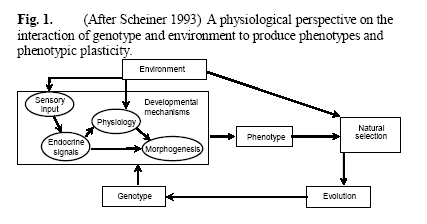Physiology and fitness consequences of life-history phenotypes in insects
NSF Cross-Disciplinary
Research at Undergraduate Institutions
D.W. Borst, S.A. Juliano,
D.W. Whitman, O. Akman, PIs
J. Jannot, Post doctoral researcher
last updated 26 August 2005
David Borst, Douglas Whitman, Olcay Akman, and I direct a project funded by the National Science Foundationís Cross-disciplinary Research at Undergraduate Institutions program for undergraduate research on plasticity of reproduction in insects. To learn about this new project, click here.
In previous CRUI projects, undergraduates in my lab study plasticity in reproductive timing and
egg production in response to food availability of grasshoppers. Greg Moehrlin
and I showed that patterns of plasticity in grasshopper
reproduction are the same as those shown in mosquito
metamorphosis. We refuted 1 of 2 basic models of plasticity, and
showed that any viable model must incorporate a period of
developmental inflexibility late in the oviposition cycle. We
also found a period late in the oviposition cycle after which egg production
becomes inflexible, and further changes in food ava ilability
have no effect on reproductive output. This result implies that nutrients from
food eaten late in reproduction must be stored for later use. In collaboration
with John Hatle, we have investigated simultaneously interpoplation differences
in reproductive tactics and the physiology that underlies those tactics.
ilability
have no effect on reproductive output. This result implies that nutrients from
food eaten late in reproduction must be stored for later use. In collaboration
with John Hatle, we have investigated simultaneously interpoplation differences
in reproductive tactics and the physiology that underlies those tactics.
In related experiments, Virginia Flanagin, Steve Haase, and I have tested the same models of plasticity for juvenile development of lubber grasshoppers. We show that there is also developmental inflexibility late in juvenile development as well. This similar pattern of inflexibility late in development for adults and juveniles seems to be repeated for a number of insects (including mosquitoes) and this suggests that such inflexibility is a general feature of insect developmental systems.
For more information please see these publications (links on publications page):
Hatle, J.D. T. Waskey Jr., & S.A. Juliano. 2006. Plasticity of grasshopper vitellogenin production in response to diet is primarily a result of changes in fat body mass. Journal of Comparative Physiology - B 176:27-34
Juliano, S.A., Olson, J.R., Murrell, E.G., & Hatle, J.D. 2004. Plasticity and canalization of insect reproduction: testing alternative models of life history transitions. Ecology 85:2986-2996.
Hatle, J. D., Andrews, A. L., Crowley, M. C., & Juliano, S.A. 2004. Interpopulation variation in developmental titers of vitellogenin, but not storage proteins, in lubber grasshoppers. Physiological and Biochemical Zoology 77:631-640
Gunawardene, E.U., Stephenson, R.E., Hatle, J.D., & Juliano, S.A. 2004. Are reproductive tactics determined by local ecology in Romalea microptera (Orthoptera: Acrididae)? Florida Entomologist 87:119-123
Hatle,
J. D., M. C. Crowley, A. A. Andrews, & S. A. Juliano. 2002.
A trade-off among age at reproduction, somatic storage, and clutch mass:
plasticity vs. geographic variation.
Oecologia
132:517-523
Flanagin, V. L., Haase, S. P., & Juliano, S. A. 2000. Effects of growth rates on development to metamorphosis in the lubber grasshopper Romalea microptera. Oecologia 125:162-169.
Moehrlin,G. S. & Juliano, S. A. 1998. Plasticity of insect reproduction: Testing models of flexible vs. fixed development in response to different growth rates. Oecologia 115:492-500.